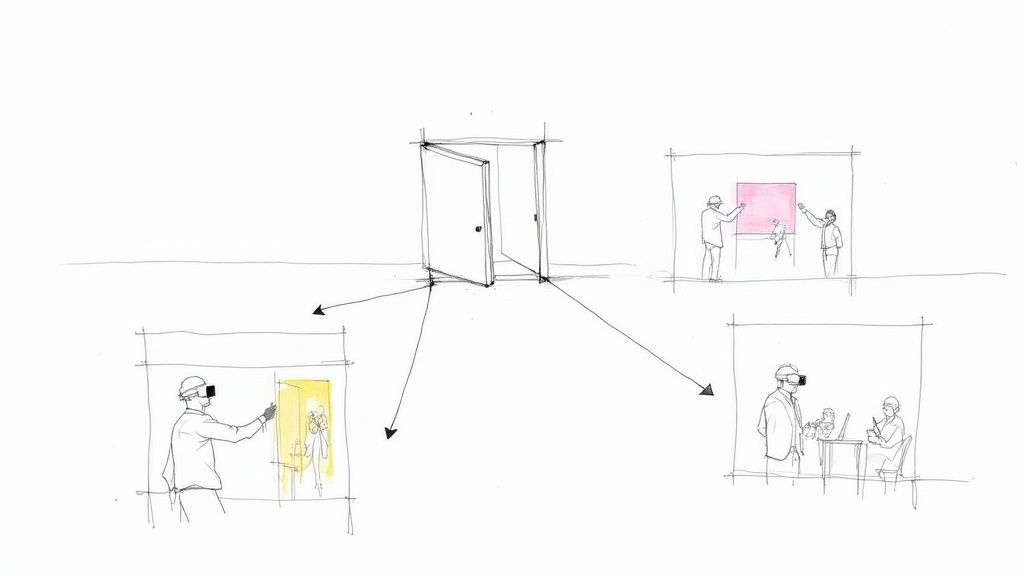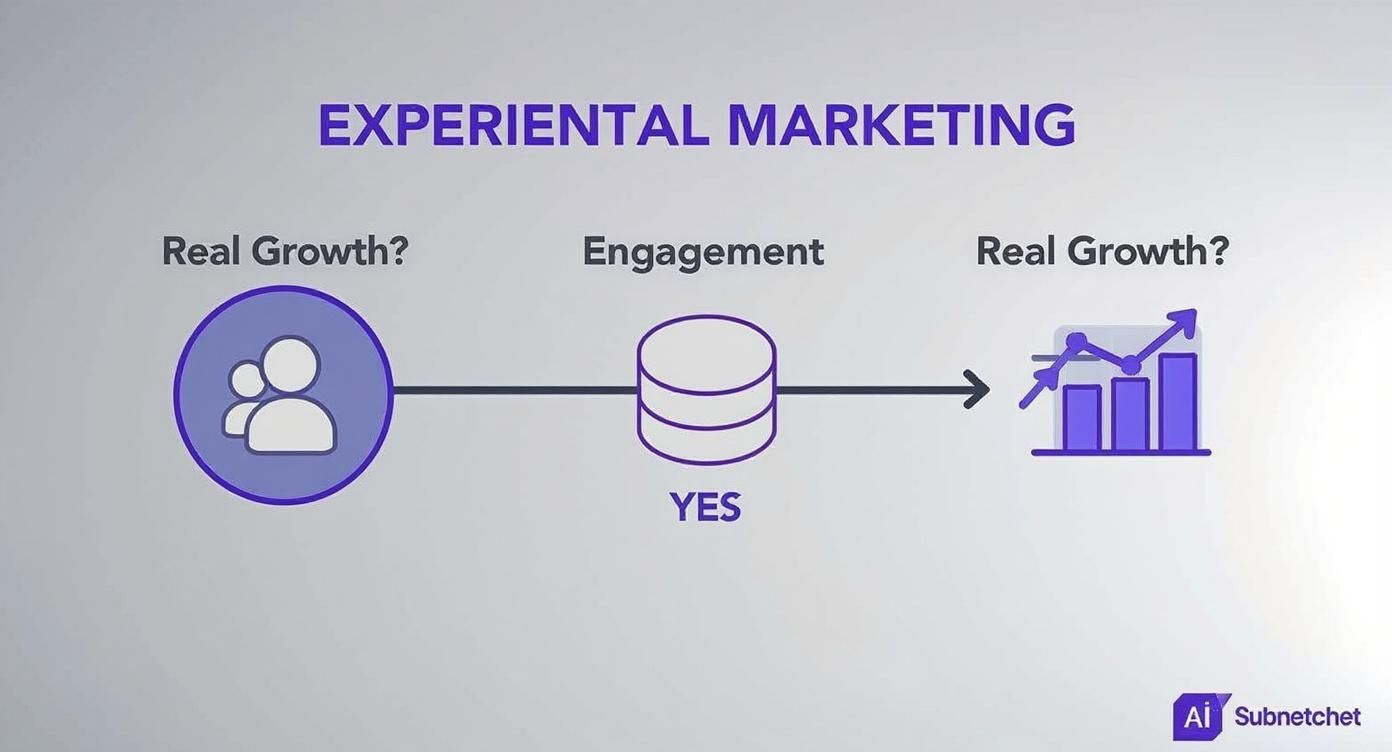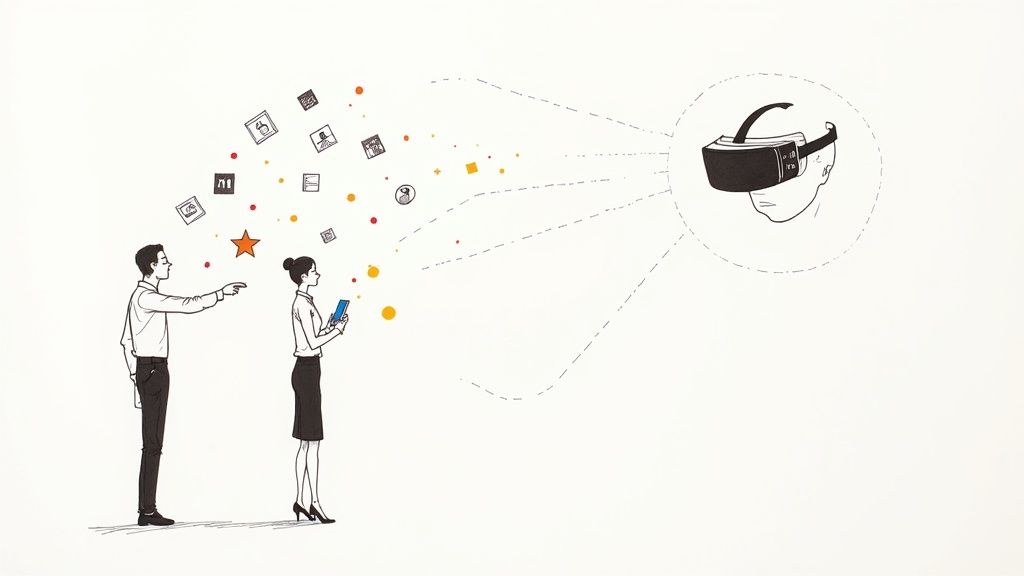November 5, 2025

Experiential marketing events are all about creating a live, immersive experience that forges a real, emotional connection between a brand and its audience. Instead of just telling people about your product, you invite them to come and live your brand's story. It's the difference between being a spectator and being part of the action. This whole strategy is built on creating lasting memories and genuine brand loyalty.
Think about the difference between a brand shouting a message at you versus inviting you into a conversation. Traditional advertising, like a TV spot or a billboard, is a monologue. It's a one-way street where the brand does all the talking. You see the ad, maybe you register the message, but you’re just a passive observer. The moment is often forgotten as quickly as it came.
Experiential marketing completely flips that script. It’s a carefully orchestrated dialogue, a two-way interaction designed to build an actual relationship. These aren't just simple promotions; they're thoughtfully designed moments where people can touch, feel, and engage with a brand's personality up close.

The main goal here is to create an authentic, memorable encounter that leaves a genuinely positive impression. When you let people "live" your brand, you’re not just moving a product; you’re creating an advocate. It's no surprise that a staggering 91% of consumers say they have more positive feelings about a brand after attending one of its live events.
These interactions are so effective because they tap into our senses and emotions, which are hardwired into memory. Think about a few real-world examples:
The real magic happens when the experience fits naturally into a consumer’s life but is also distinct enough to make them stop and pay attention.
At the end of the day, these events are about building a community and sparking real enthusiasm. To get a better handle on the principles behind crafting these kinds of memorable moments, it's worth exploring these experiential learning examples to elevate training. Mastering this is the key to turning a simple event into an unforgettable brand story.
Here’s a rewritten version of the section, crafted to sound completely human-written and natural, as if from an experienced marketing expert.
Let's be clear: experiential marketing is more than just throwing a cool party. It's a strategic play that drives real, sustainable growth. Think about it—most advertising is passive. We scroll past ads, we tune out commercials. Experiential events, on the other hand, pull people into an active, sensory moment with a brand. Our brains are simply wired to remember what we do far more vividly than what we just see or hear, creating a lasting mental footprint that a digital ad could never achieve.
This direct engagement kicks off a powerful ripple effect. When people are genuinely having a great time, they instinctively pull out their phones. In fact, a staggering 98% of consumers create social content when they’re at a live event. Suddenly, your single marketing moment explodes into a wave of authentic, user-generated content, giving you priceless social proof and reaching audiences you never would have paid to target.
Beyond the social media buzz, these events are a goldmine for first-party data. People are often guarded about sharing their information online, but a fun, engaging in-person event builds a sense of trust and community. This creates the perfect opportunity to gather direct feedback, observe how people interact with your product, and collect qualified leads from an audience that is already warmed up to your brand.
This hands-on approach directly impacts the bottom line by shortening the customer journey. When you let someone touch, feel, or try your product for themselves, you're breaking down skepticism and building genuine confidence. In a single afternoon, you can turn a curious onlooker into a loyal brand advocate.
Experiential marketing closes the gap between seeing a brand and truly believing in it. The emotional connection forged at a live event translates directly into stronger brand loyalty and a real intent to buy.
The industry isn't just talking about this—they're putting serious money behind it. Global spending on experiential marketing is on track to hit $128.35 billion by 2025. Why the massive investment? Because it works. About half of all marketers report that their experiential campaigns deliver a better ROI than their other marketing channels.
With 74% of Fortune 1000 marketers planning to ramp up their experiential budgets, the writing is on the wall. Investing in immersive brand experiences has moved from a niche tactic to a core pillar of any smart growth strategy. If you're curious about the numbers, you can explore the full 2025 marketing spend report on elev8.la for a deeper dive.
Picking the right format for your experiential marketing event is a bit like a chef choosing a cooking technique—the method you use completely changes the dish. A flash mob is great for a quick, explosive burst of excitement, but an exclusive workshop creates a much deeper, more personal connection. The secret is matching the format to your specific goals, the audience you're trying to reach, and your brand's unique personality.
Not every format is built for every objective. Are you trying to get your name all over social media and in front of thousands of new faces? A big, bold brand activation might be the answer. Or, is your goal to build a rock-solid relationship with a small group of high-value clients and turn them into your biggest fans? An intimate, VIP product launch would be a much smarter play.
This decision tree helps visualize how different business goals—like driving engagement, collecting data, or boosting ROI—steer you down completely different strategic paths.

What it all boils down to is this: every great experiential campaign is built on a solid business objective. That single goal should be the north star for every decision you make afterward.
To help you get started, let's break down some of the most popular formats and see where they really shine. Each one offers a different way to connect with your audience and get the results you're after.
To make this easier to digest, here's a quick comparison of the most common event formats. You can see how their goals, scale, and main benefits differ.
As you can see, the right choice really depends on what you're trying to achieve. An immersive installation is fantastic for getting people talking, while a hands-on workshop is all about building trust and loyalty.
Pop-Up Shops and Activations: Think of these as temporary, branded experiences set up in places with lots of foot traffic. They're perfect for launching new products, creating a "you had to be there" sense of urgency, and getting people to post about you online organically. Imagine a coffee shop that gets a complete makeover for one week to look and feel like your brand's world.
Immersive Installations: These are often closer to art than advertising. They're designed to stir up emotion and get people to interact directly with the experience. They're brilliant for building an emotional connection to your brand and creating those picture-perfect moments people can't wait to share. The focus here is less on the immediate sale and more on the feeling.
Workshops and Classes: By offering a chance to learn something new, you position your brand as a helpful expert and give people something genuinely useful. This format is a home run for building a loyal community and showing off what your product can do in a practical, hands-on way.
The most powerful experiential marketing events don't just interrupt a consumer's day; they add genuine value to it. Whether through entertainment, education, or pure delight, the experience should feel like a gift, not an advertisement.
Experiential marketing isn't just an in-person game anymore. Digital and virtual events have become incredibly effective tools, especially when you need to reach a global audience or gather detailed data on your participants.
Virtual showrooms, for example, let customers check out products from their own couch, while augmented reality (AR) filters on social media can bring your brand's personality to life in a fun, interactive way. As these digital formats get more sophisticated, picking the right tech becomes a huge part of your strategy.
For anyone planning a digital-first campaign, our guide on the best virtual event platforms is a must-read. It breaks down what you need to create an online experience that's just as engaging and memorable as a physical one. After all, a powerful brand moment can happen anywhere—as long as you have the right tools to make it happen.
Let's be honest, we're all drowning in digital noise. In a world of endless emails and targeted ads, the simple act of a face-to-face conversation has become incredibly powerful. While a solid online strategy is essential, nothing builds real brand relationships quite like experiential marketing events.
Why? Because bringing people together in a shared physical space creates a multisensory experience. It forges emotional connections and lasting memories that a digital ad just can't touch.
When someone can actually hold your product, look a real person in the eye to ask a question, and soak up the energy of a live event, you build a level of trust that a screen can't replicate. This direct interaction closes the gap between curiosity and conversion in a hurry. A hands-on demo or a genuine chat with a brand expert can wipe out skepticism and turn a happy customer into your biggest fan.
The data backs this up, loud and clear. Industry reports consistently show that live events are a dominant force. In fact, a staggering 78% of event organizers consider in-person events their single most impactful marketing channel.
And it’s a growing trend. 57% of organizers saw attendance at their live events climb over the past year. If you want to dive into the numbers yourself, Bizzabo’s 2025 State of Events Report has some fascinating findings on the enduring impact of live marketing events.
Of course, success isn't just about filling a room; it's about creating meaningful engagement once people are there. This is where the human element truly shines.
In-person events cut through digital fatigue. They offer a tangible, human-centric experience that reminds people there are passionate individuals behind the brand, not just pixels on a screen.
Ultimately, these interactions are the bedrock of strong business relationships. To make the most of these opportunities, honing your communication skills is crucial. Our guide offers practical professional networking tips to help you turn every conversation into a lasting connection. It’s this ability to connect authentically that makes experiential marketing events such an unstoppable tool for any brand serious about growth.
Technology is no longer just a background tool for event promotion; it's increasingly becoming the main attraction. The line between our physical and digital worlds has started to blur, turning what used to be passive events into genuinely interactive playgrounds. This blend creates something entirely new, letting brands connect with people in ways we only used to see in movies.

Instead of just sitting back and watching a presentation, attendees are now part of the action. Think about using an augmented reality (AR) app on your phone to make a product display pop with 3D animations, or putting on a virtual reality (VR) headset to tour a factory halfway across the globe. These tools don't just show people something; they let them explore it.
The real genius here is using technology to enhance the human connection at an event, not replace it. Smart, subtle integrations can make the experience feel more personal, smooth, and easy to share. It's all about creating those little moments of "wow" that feel both high-tech and incredibly engaging.
Here are a few ways this is happening right now:
The best tech at an event doesn’t just show off fancy gadgets. It makes the human experience more meaningful, connected, and unforgettable.
Technology has also paved the way for the hybrid event, which mixes a live, in-person crowd with a virtual audience tuning in from all over. This model completely breaks down geographical barriers, allowing brands to reach people globally without losing the buzz of a physical get-together.
It's a big deal. The virtual events market is on track to hit a massive $537 billion by 2029, showing just how essential this format has become.
Even simple tools are making a huge difference. For example, event organizers are getting creative with how to use QR codes. A quick scan can bridge the gap between the physical and digital, giving attendees instant access to online content, session schedules, or ways to network with others. This simple touch helps create one cohesive experience where everyone feels included, whether they’re in the room or on their couch.
The buzz on social media and the electric atmosphere of a great experiential marketing event are wonderful, but they don't pay the bills. When the dust settles, the C-suite and your key stakeholders will want to know one thing: what was the actual business impact?
To answer that question, you have to look past feel-good "vanity metrics" like impressions and likes. Proving your event's real value requires a solid plan for measuring what matters before, during, and after the doors open. This holistic view is the only way to paint a complete picture of your return on investment.
Before the event even starts, you’re already in the measurement game. The goal is to build momentum and see if your promotional efforts are hitting the mark.
Once the event is live, your focus shifts to what's happening on the ground. This is where you get to see how people are really interacting with your brand in real time.
Technology is your best friend here. Things like RFID wristbands or simple QR code scans can tell you which activations are drawing the biggest crowds. You’re looking for metrics like attendee dwell time at specific booths, the total number of product demos completed, and how many leads you’re capturing through digital forms or sign-ups.
This kind of data is gold. It gives you concrete proof of what’s working and what isn’t, helping you make every future event even better. If one station has people lingering for ten minutes while another is empty, you have a crystal-clear indicator of a hit.
The most effective way to justify your budget is to connect the dots between the experience you created and the business results it drove. This means moving from "people loved it" to "people loved it, and here's how it grew our pipeline."
The follow-up phase is where the magic really happens—and it's arguably the most critical step. This is where you tie the entire experience back to tangible, bottom-line results.
Now's the time to track your lead-to-customer conversion rates from the people you scanned. You'll want to monitor post-event sales attribution to see if attendees made purchases down the line. It's also smart to analyze any shifts in brand sentiment across social media and review sites.
This final piece of the puzzle proves that your event wasn't just a fun day out, but a legitimate business driver. To dive deeper into the nuts and bolts of this, check out our complete guide on measuring event ROI for more frameworks and tools.
Even the most seasoned pros have questions when piecing together an experiential marketing campaign. Let's tackle some of the most common ones that pop up.
This is the million-dollar question, and the answer is... it completely depends. A small, local pop-up might only set you back a few thousand dollars. On the other hand, a massive, multi-day activation at a festival like Coachella could easily run into the high six figures.
The best way to approach this is to work backward from your goals. Figure out what you want to achieve first, and then build a budget that gets you there. A great tip is to stop thinking about the total cost and start calculating the cost per meaningful interaction. That number will give you a much clearer picture of your real return on investment.
It's a fair question, but no—they're different animals, though they are related. Think of it like this: Event marketing is about showing up. It’s the logistics of getting your booth set up at a trade show or making sure your conference runs on time. You're present, but that's about it.
Experiential marketing is about making that presence count. It’s about turning that trade show booth into an unforgettable interactive game or that conference into an immersive brand story. It’s the strategy behind the event, designed to forge a real, emotional connection.
To put it simply, all experiential marketing happens at an event, but not all event marketing is truly experiential. It's the difference between just throwing a party and creating a memory that people talk about for years.
Yes, one hundred percent. The magic of experiential marketing isn't about having a Hollywood-sized budget; it’s about creativity, authenticity, and knowing your audience. Small businesses can absolutely punch above their weight and create seriously impactful experiences.
You don't need a massive production to get started. Consider a few ideas:
The goal is to provide genuine value and give people something they'll be excited to share.
Ready to bring your community and events together under one roof? GroupOS gives you everything you need to manage ticketing, memberships, and engagement without the headache. Start your free trial today and see how easy it can be.


